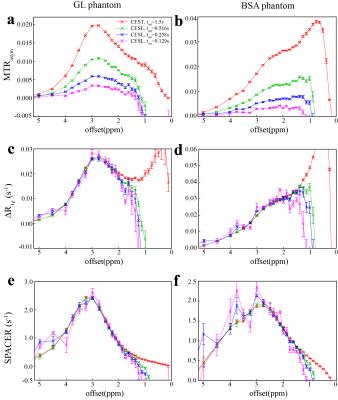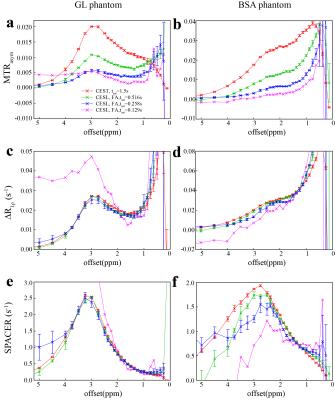1977
Quantitatively Evaluate the Chemical Exchange Effect in Off-resonance Spin Lock Using Perturbation of Longitudinal Relaxation Rate in Rotating Frame (PLRF) Analysis1Center for MRI Research, Peking University, Beijing, People's Republic of China, 2MR Research Group, GE Healthcare China, Beijing, People's Republic of China
Synopsis
Chemical exchange effect can be evaluated by off-resonance spin-lock sequence (CESL), but it remains unclear whether the effect is accurately reflected. In this study, with the help of perturbation of longitudinal relaxation rate in rotating frame (PLRF) analysis, we quantitatively compared signal from CESL and chemical exchange saturation transfer (CEST) sequences and tested the condition for acquiring high-quality signal from CESL sequence which can accurately reflect chemical exchange effect.
PURPOSE
Besides the conventional chemical exchange saturation transfer (CEST) sequence, an off-resonance spin-lock (CESL) sequence can also be applied to evaluate chemical exchange effect1,2. The advantage of CESL sequence over CEST sequence is the reduction of saturation time. However, with an inhomogeneous B0 field, the angle of the rotation pulses in CESL sequence would not be ideal, which may probably affect the accuracy of CESL signal. Till now, few studies focus on whether the CESL signal is still accurate with B0 inhomogeneity. Using perturbation of longitudinal relaxation rate in rotating frame (PLRF) analysis, we compared the signals from short-saturation-time CESL sequence and long-saturation-time CEST sequence to evaluate the accuracy of the CESL signal.THEORY
Based on analytical solution of Z-value, the process of chemical saturation transfer with saturation pulse amplitude B1 and frequency offset Δω could be treated as T1ρ relaxation along the direction of $$$\overrightarrow{\omega_{eff}}=(\gamma B_{1}, 0, \triangle\omega)$$$ tilted by an angle $$$\theta=\arctan(\gamma B_{1}/\triangle\omega)$$$ off the Z axis, combined with T2ρ relaxation perpendicular to the direction of $$$\overrightarrow{\omega_{eff}}$$$ 2,3. If the magnetization along T2ρ direction ($$$M_{T_{2\rho}}$$$) has a nonzero contribution to the final magnetization along Z axis before signal acquisition, the signal would be contaminated, which places constrains on repeatable quantifications in practice. To avoid the contamination from $$$M_{T_{2\rho}}$$$ in CESL sequence, the flip angle of the rotation pulses β is frequency offsets variedly set to θ. It is theoretically ideal, but would be problematic with an inhomogeneous B0 field. As a result, the acquired signal at any offset may be significantly biased. To overcome this problem, a fixed flip angle (FA) β could be applied. Thus, the contamination from $$$M_{T_{2\rho}}$$$ would probably be neglected or near a given frequency offset which satisfies $$$\beta\approx\theta$$$. It should be noticed that a change in saturation time (tsat) would result in an alteration of ΔZ, therefore, to compare the signal from CESL sequence (short tsat) with that from conventional CEST sequence (long tsat) PLRF analysis is used for quantification, specifically, for converting traditional to ΔR1ρ and/or SPACER3.EXPERIMENTS
Phantoms with glucose and glutamate (GL phantom) or bovine serum albumin (BSA phantom) were prepared and used to test the effect of CESL. MnCl2 was added into phantoms for adjusting relaxation times. Continuous wave rectangular saturation pulse followed by a SE-EPI sequence was used for CEST imaging, in which B1=1μT, TR=2s and tsat=1.5s. were applied. CESL sequences with or without a fixed flip angle (β=14.93°) were tested. For both kinds of CESL sequences, two B0 inhomogeneity (ΔB0=30Hz and 50Hz) and three tsat (516ms, 258ms, and 129ms) as well as B1=1μT and TR=2s were applied for imaging. The corresponding maps of B1, T1 and T2 were also obtained for quantification.RESULT
Signal from the CEST sequence is treated as the gold standard to measure chemical transfer effect. If a fixed flip angle is not applied, the accuracy of CESL signal will strongly depend on B0 inhomogeneity (ΔB0). When facing relative small ΔB0 (e.g. 30Hz), after quantification, the spectra (ΔR1ρ and SPACER) from CESL sequence fits fairly well to the corresponding spectra from CEST sequence in the range of 1ppm to 4ppm, although with a decreased tsat there is a little difference between each pair of spectra (Fig. 1). However, when a relative larger ΔB0 comes (e.g. 50Hz), the spectra (ΔR1ρ and SPACER) from CESL sequence have poor performance. Specifically, in the range from 1ppm to 2ppm (Fig. 2), significant difference exists between these spectra and corresponding spectra from CEST sequence. On the contrary, if a fixed flip angle is applied, in the offset range near the frequency offset satisfying β=θ, specifically Δω round 160Hz for β=14.93° and B1=1μT, the spectra (ΔR1ρ and SPACER) from CESL sequence are nearly identical to the corresponding spectra from CEST sequence, despite the values of ΔB0 and tsat (Fig. 3, 4).DISCUSSION and CONCLUSION
Theoretically, CESL sequence is feasible in measuring chemical exchange effect with a shorter saturation time than that required by the CEST sequence. This study reveals that when there is great difference between θ and the flip angle β, CESL sequence cannot provide reliable signal. To ensure the CESL signal is of high quality, the B0 inhomogeneity should be relative small and tsat should be relative large; or a fixed flip angle β could be applied to maintain the high quality of CESL signal at the offset satisfying $$$\beta\approx\theta$$$.Acknowledgements
No acknowledgement found.References
1. Tao Jin, Seong-Gi Kim, Advantages of chemical exchange-sensitive spin-lock (CESL) over chemical exchange saturation transfer (CEST) for hydroxyl- and amine- water proton exchange studies, NMR Biomed., 2014; 27(11): 1313-1324
2. Moritz Zaiss, Peter Bachert, Chemical exchange saturation transfer (CEST) and MR Z spectroscopy in vivo: a review of theoretical approaches and methods, Phys. Med. Biol. 2013; 58(22): 221-269
3. Yi Wang, Yaoyu Zhang, Xuna Zhao, Bing Wu, Jia-Hong Gao, Perturbation of Longitudinal Relaxation Rate in Rotating Frame (PLRF) Analysis for Quantification of Chemical Exchange Saturation Transfer Signal in a Transient State, Magn Reson Med 2016; in press
Figures



